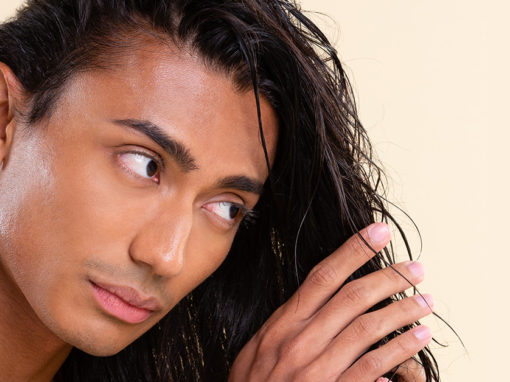If you’ve recently started to notice excessive hair loss with loose strands of hair in your comb or on your pillow, chances are that this could be an early sign of balding.
However, like all signs of ageing, male pattern baldness or androgenetic alopecia is a gradual process.
Fortunately, several visible signs help detect a receding hairline, and if men act quickly, it is possible to stop the progress quite early.
The article points out some critical warning signs that you need to look out for to catch a receding hairline in its early stages.
The article is a part of our comprehensive series on “Receding hairline in men: Causes and treatment options.”
What age does a receding hairline start in men?
Studies have shown that a receding hairline in men can start anytime around puberty. However, by around the 30s, a receding hairline will slowly begin to be visible.
For many, the process initially starts above the temples and gradually progresses back across the top of the head.
What does an early receding hairline look like?
As a receding hairline shows no single pattern, it is not always easy to tell if your hairline is receding or not. One good way to know is by gently running your fingers on the head and checking if hair strands come out with ease.
Alternatively, you could compare your current photograph with an old one to see if your hairline is receding or not.
If you are still doubtful, the best option to clear the confusion is to book an appointment with a certified dermatologist.
Following are some notable signs of hair loss and a receding hairline in men:
1. Change in your hairline
Although a visible change in the shape of your hairline can happen anytime after puberty, most men experience it in their thirties.
Receding hairline usually starts above the temples and gradually moves back across the top of the head, leaving a circular patch without hair. Sometimes an M-shape will be formed in the front side, quite popularly known as widow’s peak.
The most common reasons for changes in your hairline are hormonal issues or genetic predisposition.
2. Poor hair growth
This is another important symptom that indicates a receding hairline. For a healthy person, hair on the scalp grows about .3 to .4 mm/day. Therefore, at any point in time, a random number of hairs will be in three stages of growth and shedding.
- Anagen– Active phase of hair growth.
- Catagen– Transitional phase
- Telogen- Resting phase
If you notice that your hair is growing very slowly or does not grow back well after a haircut, this could be a clear indication of a receding hairline.
3. Excessive hair loss after brushing or showering
On average, people tend to lose around 50 to 100 hair in a day. So if you happen to notice a few strands of hair after a shower or while brushing your hair, it is usually not a big cause of concern.
On the other hand, if you happen to observe excessive hair fall throughout the day, you might have entered the first stage of balding.
Before you panic, understand that hair loss may or may not be permanent. Temporary hair loss can happen for a few days – few weeks without causing any long-term harm.
4. Loss of hair from the crown portion
Most men affected by the symptoms of balding notice their hair is growing thinner on the top circular region of the head.
Since this is a difficult place to notice, most men don’t realize the problem until they have lost close to 50% of the hair from the crown area.
Hair follicles that are highly sensitive to DHT are located in the top and the front portion of the head. The back and side portion of the scalp appears somehow to be more resistant to the effects of DHT.
If detected early, there are effective treatment options to slow down the progress.
5. Thinning eyelashes, eyebrows or beard
Unlike most people think, your head is not the only portion where you could lose your hair. An autoimmune condition called Alopecia areata is known to cause the immune system to attack the hair follicles.
This condition can cause patches of hair to fall from beard, nose hair, chest, eyelashes or pubic areas. In some instances, it can cause hair to fall from the entire head (alopecia totalis) or the whole body(alopecia Universalis).

6. Sudden loss of patches of hair
In some instances, you might notice a stinging, itching or burning sensation before hair loss phases start. This could be a sign of infection and should be addressed immediately.
7. White spots on nails
Your nails often give a clue to what is happening with your hair. If you notice small craters, pitting or white patches on nails, it could be a warning sign that the health of your hair might be at risk.
If you notice hair fall along with any of the aforementioned symptoms, it is advisable to consult a certified dermatologist without losing time.
Check out the available treatment plans for hair loss by andSons now.
References
Sineida Berbert Ferreira,Morton Scheinberg,Denise Steiner,Tatiana Steiner,Gustavo Longhi Bedin,c and Rachel Berbert Ferreira(8 Dec 2016)Remarkable Improvement of Nail Changes in Alopecia Areata Universalis with 10 Months of Treatment with Tofacitinib: A Case Report. Available at https://www.ncbi.nlm.nih.gov/pmc/articles/PMC5216217/ [Accessed 1 Aug 2021]
Hans Wolff,Tobias W Fischer,and Ulrike Blume-Peytavi(8 Dec 2016)The Diagnosis and Treatment of Hair and Scalp Diseases. Available at https://www.ncbi.nlm.nih.gov/pmc/articles/PMC4908932/ [Accessed 1 Aug 2021]


